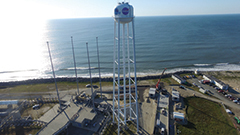Australian aerospace company will begin missions from Wallops Island in 2020, including “rapid call-up missions” for fast satellite deployment
By Carol Vaughn
Rocket Lab on Thursday, Dec. 12, officially opened the company’s first U.S. launch site on Wallops Island.
The company’s first mission from Wallops will be for the U.S. Air Force in 2020, according to a press release.
Construction on the complex at the Mid-Atlantic Regional Spaceport started in February.
Launch Complex 2 is designed to support “rapid call-up missions,” according to the release, which said “the ability to deploy satellites to precise orbits in a matter of hours, not months or years, is increasingly important to ensure resilience in space.”
“Virginia is proud to be the home of Rocket Lab’s first facility in the United States — the advancements in aerospace happening right here in our Commonwealth will boost our economic competitiveness and ensure Virginia’s continued position as a leader in space flight,” Gov. Ralph Northam said in a press release from his office.
Dave Pierce, NASA Wallops Flight Facility director, said completing the launch pad “from scratch in less than a year is a phenomenal achievement.”
“We are proud to have Rocket Lab as a partner and we’re looking forward to Electron’s first flight from Wallops in early 2020,” Pierce said.
Launch Complex 2 includes a pad made from more than 1,400 cubic yards of concrete, a 66-ton launch platform, and a 44-foot, 7.6-ton “strongback,” which lifts the rocket into launch position.
The U.S. Air Force’s Space Test Program will be the first customer to launch from the complex, officials announced at a Dec. 12 press conference.
The mission, set to happen in the second quarter of 2020, will involve the launch of one research and development micro-sat on a 57-foot-tall Electron rocket.
The Electron is capable of carrying a payload of up to 500 pounds to orbit, according to Rocket Lab.
“It’s an honor and privilege to be launching a U.S. Air Force’s Space Test Program payload as the inaugural mission from Launch Complex 2,” said Peter Beck, Rocket Lab’s founder and chief executive.
“We’ve already successfully delivered STP payloads on Electron from Launch Complex 1, and we’re proud to be providing that same rapid, responsive, and tailored access to orbit from U.S. soil,” he said, adding, “With the choice of two Rocket Lab launch sites offering more than 130 launch opportunities each year, our customers enjoy unmatched control over their launch schedule and orbital requirements. Rocket Lab has made frequent, reliable and responsive access to space the new normal for small satellites.”
An Air Force official said having the launch site on Wallops Island strengthens the nation’s ability to provide responsive and reliable access to space.
“We look forward to Rocket Lab successfully launching the STP-27RM mission from Launch Complex 2 next spring, which will test new capabilities that we will need in the future,” said Col. Robert Bongiovi, director of the Air Force Space and Missile Systems Center’s Launch Enterprise.
Virginia Space Chief Executive Officer and Executive Director Dale Nash called the opening of the complex “a significant milestone and a remarkable achievement made possible by the strong partnership with Rocket Lab and NASA.”
Nash cited strong support from the Commonwealth of Virginia and the Air Force, as well as a skilled contractor team, as factors contributing to the successful completion of the complex.
“We look forward to a busy manifest of Electron launches coming off LC-2,” Nash said.
Shaun D’Mello, Rocket Lab vice president of launch, said the rapid pace of construction was made possible by the tireless support of teams from Virginia Space, which owns and operates MARS, and NASA Wallops Flight Facility.
“The fact that we have an operational launch site less than a year after construction began is testament to the hard work and dedication of the Virginia Space and NASA teams, as well as the unwavering support of our local suppliers. Thank you for being a huge part of enabling us to open access to space. We’re excited to embark on the next phase of working together – regular and reliable Electron launches from the United States,” he said.
Rocket Lab’s first site, Launch Complex 1, is located on New Zealand’s Māhia Peninsula.
Rocket Lab selected the Mid-Atlantic Regional Spaceport as the location of Launch Complex 2 because of the wide orbital inclinations the site can support, as well as the rapid planned construction timeframe, according to the release.
More than 150 local construction workers and contractors were involved in the project.
The complex can support up to 12 missions per year, supplementing the 120 launches annually that are possible from Rocket Lab’s New Zealand launch site.
Launch Complex 2 also will include an Integration and Control Facility at Wallops Research Park for processing payloads and Electron launch vehicles prior to liftoff.
Launch Complex 2 is expected to employ up to 30 people in engineering, launch safety, and administrative positions in the coming year, according to the release.





